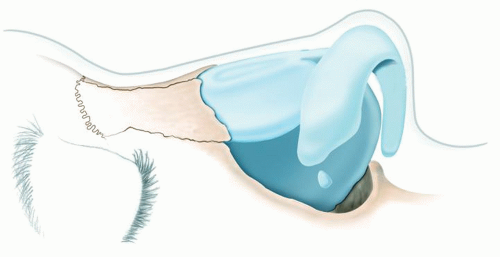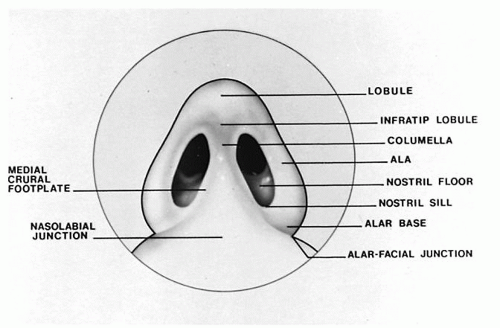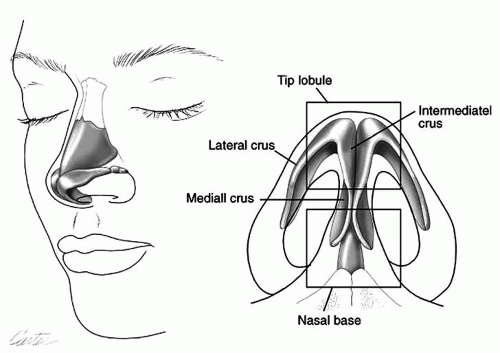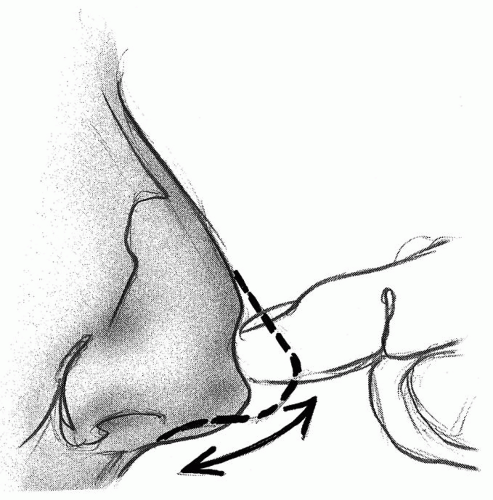Nasal Tip Surgery
Tatiana K. Dixon
Dean M. Toriumi
Creating a natural nasal tip contour is a complex task and requires a three-dimensional approach. The surgeon must have a clear understanding of what looks normal and which methods should be used to attain that natural contour. The lower third of the nose is composed of multiple subunits (tip, columella, facets, and alae), and the curvilinear surface transitions between these nasal subunits create highlights and shadows. Even the slightest concavity or asymmetry in the tip results in unnaturally positioned shadows, which detract from the person’s appearance on frontal view. When contouring the nasal tip, the surgeon should focus more on creating favorable shadows and highlights and less on narrowing. Simply narrowing the nasal tip may create abnormal shadowing between the nasal tip and alae resulting in a pinched-tip look. Careful consideration of the underlying anatomic structures and proper use of suturing and repositioning techniques in combination with cartilage grafting will help create favorable, natural-appearing tip contours that will better withstand the forces of scar contracture over time (1).
ANALYSIS AND DIAGNOSIS
Analysis of the tip, which is only one component of the nasal examination, is not undertaken in isolation. For the sake of brevity, this chapter focuses only on the contribution of the tip to the form and function of the nose. The reader is encouraged to consult another source (Chapter 179) for a thorough overview of nasal analysis.
Before undertaking an intelligent analysis of the nasal tip, it is imperative to have a mastery of nasal anatomy as well as a clear understanding of the ideal contours and relationships of the nose (Figs. 182.1, 182.2, 182.3, 182.4, 182.5, 182.6).
When evaluating the tip, the surgeon should attempt to visualize the underlying structures by inspecting the skin. The first step is to try to quantify the thickness of the skin envelope. Most surgeons classify patients into thin, medium, and thick skin categories. This can be estimated by inspection and palpation of the skin by rolling it between the thumb and index finger. When assessing skin thickness, freckles are a reliable indicator of thin skin (2). Thick skin tends to be more sebaceous and have thick nostril rims and less defined alar facets.
Understanding the implications of skin thickness should radically alter the surgical plan with an emphasis on long-term results. Thin-skinned patients require a high degree of precision and symmetry without sharp edges of bone or cartilage, lest they be visible shortly after surgery.
Thin-skinned patients should also be advised that they have a greater risk of developing small, visible asymmetries than patients with thicker skin. Conversely, they will enjoy a more rapid course of healing than their thick-skinned counterparts.
Thick-skinned patients, on the other hand, have fewer surgical options than those with thin skin. It is critical that the surgeon not promise a result that is impossible to attain. For example, thick-skinned patients often request a more refined tip. Although a bulbous tip can be improved, a thick-skinned nose will not have defined soft triangles or a “chiseled” appearance postoperatively, despite the surgeon’s efforts. Many thick-skinned patients also have large noses and want them made smaller. Because a thick skin envelope will not contract to any significant degree, it is a mistake to expect that cartilage resection alone will refine the contour of the tip and result in a smaller nose. Counsel these patients that, although their tip can be refined, it often necessitates the use of grafts to stretch and refine the thick tip skin and therefore requires increasing projection to achieve that definition. This increase in projection will have the added benefit of being able to keep the dorsum of the nose high, which will increase the appearance of a narrow nose. Otherwise, they risk having a loose, ptotic, poorly supported tip. Too many patients with thick skin undergo multiple revisions wherein the revising surgeon
attempts to trim “just a little bit more,” which only exacerbates the problem (Fig. 182.7).
attempts to trim “just a little bit more,” which only exacerbates the problem (Fig. 182.7).
Palpation of the tip and its ability to recoil when depressed can identify weak lower lateral cartilages or a low anterior septal angle (Fig. 182.8). The septum can also be palpated by placing the tip of the thumb and index finger in each of the nasal vestibules. This maneuver facilitates recognition of a weak or deviated caudal septum (2).
Evaluation of the tip must include assessment of the tip supporting structures. Anderson’s tripod model of the nasal tip clarified the dynamics of altering tip support (3). In it, the conjoined medial crura represent one leg of the tripod and the lateral crura the other two. Tip position, therefore, is a consequence of the combined forces of the three legs of the tripod as well as the support provided by the caudal septum (Fig. 182.9). This model illustrates the variable contributions of the medial and lateral crural length when assessing projection, rotation, and the columella -labial angle.
The medial crura should be inspected by looking at the nasal base. Medial crural length has several surgical implications. Short medial crura provide little tip support and will require reinforcement to prevent postoperative loss of projection and counterrotation. If the surgeon intends to rotate the tip by performing a cephalic trim of the lateral crura, the poor support of short medial crura will preclude any meaningful cephalic rotation. Similarly, long medial crura may provide excellent tip support, but if the nose needs to be deprojected, techniques such as a full transfixion incision will have minimal impact. These long medial crura will likely need to be modified to deproject the nose. Any deficiencies in these major tip support mechanisms need to be addressed at the time of surgery.
Important parameters to assess when analyzing the lateral view of the nasal tip are projection and rotation. Assessment of tip projection must be undertaken in the context of the entire profile. The nasofrontal angle, depth of the radix, and chin all affect the appearance of nasal projection (Fig. 182.10). When examining an abnormally projected nose, the surgeon must identify where in the nose the projection is distorted. For instance, in an overprojected nose, the medial crura may be excessively long, the domes may be too tall, or the anterior septal angle
may be too anteriorly positioned. Similarly, short medial and lateral crura, a low anterior septal angle, flat domes, or a hypoplastic premaxilla can result in an underprojected nose. Sometimes these factors occur in combination. Therefore, although recognizing that a nose is over- or underprojected is an important first step, the appropriate treatment options are widely divergent depending on the reason for the deformity. Unless the surgeon can identify these subtleties, good results are only a product of chance.
may be too anteriorly positioned. Similarly, short medial and lateral crura, a low anterior septal angle, flat domes, or a hypoplastic premaxilla can result in an underprojected nose. Sometimes these factors occur in combination. Therefore, although recognizing that a nose is over- or underprojected is an important first step, the appropriate treatment options are widely divergent depending on the reason for the deformity. Unless the surgeon can identify these subtleties, good results are only a product of chance.
 Figure 182.5 Ideal nasal tip contour. Note the triangular base view with an uninterrupted arch from alar rim to tip to alar rim. |
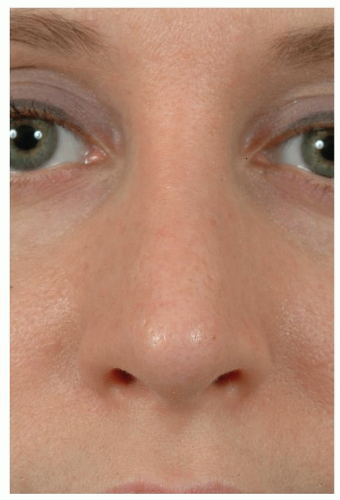 Figure 182.6 Ideal nasal tip contour with a smooth transition between the tip lobule and the well-supported nasal sidewall without bulbousness or pinching. |
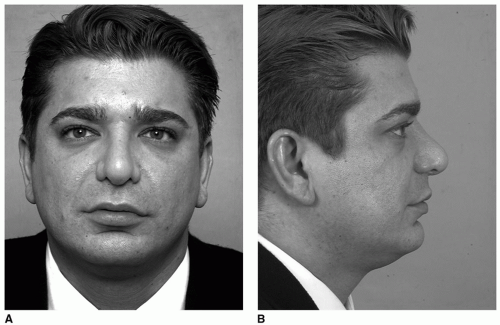 Figure 182.7 This patient had a bulbous tip and thick skin. After several reductive procedures, the tip is poorly supported and unrefined. |
Ideal rotation is 90 to 100 degrees in males and 100 to 120 degrees in females. This varies according to the height of the patient as shorter patients tolerate more
rotation and taller patients require less rotation to avoid seeing too much nostril on the frontal view. The perceived rotation is affected by the position and contour of the nasolabial angle. Another important component is the alar-columellar relationship, with approximately 2- to 4-mm columellar show being considered aesthetic. Lastly, the double break and supratip break are important components that must be maintained or created to ensure a natural appearance of the tip. The double break is formed by the natural divergence of the intermediate crura (Fig. 182.11), and the supratip break is the transition from the tip-defining point to the dorsum.
rotation and taller patients require less rotation to avoid seeing too much nostril on the frontal view. The perceived rotation is affected by the position and contour of the nasolabial angle. Another important component is the alar-columellar relationship, with approximately 2- to 4-mm columellar show being considered aesthetic. Lastly, the double break and supratip break are important components that must be maintained or created to ensure a natural appearance of the tip. The double break is formed by the natural divergence of the intermediate crura (Fig. 182.11), and the supratip break is the transition from the tip-defining point to the dorsum.
 Figure 182.9 Tip position is a consequence of the combined forces of the three legs of the tripod as well as the support provided by the caudal septum. |
When assessing the frontal view, subtle highlights and shadows impart a three-dimensional perspective. First, the aesthetically pleasing nasal tip has a horizontally oriented tip highlight formed by the divergence of the intermediate crura and the paired domes (Fig. 182.12). The tip highlight should gradually transition to the alae without a deep shadow (1). The average width between tip-defining points is about 8 mm, but this can vary between 6 and 14 mm based on overall facial width, base width, and cultural norms (4). Of equal importance, there is a subtle shadow in the supratip region that continues laterally into the supraalar groove, representing the supratip break. This shadow creates the appearance of a refined tip and is caused by the transition between the most projecting point of the domes and the more posteriorly positioned septum (1).
Tip deformities and nasal obstruction can be a result of irregularities in the shape and rigidity of the lower lateral cartilages. Two important and frequently overlooked
tip deformities are cephalically positioned lateral crura and internal curvature of the lateral crura. Cephalically positioned lateral crura are often the cause of a dynamic airway obstruction because of poor support of the lateral nasal wall. A hypermobile nasal sidewall is susceptible to collapse on inspiration, which narrows the internal nasal valve. Aesthetically, cephalic positioning of the lateral crura often appears as a bulbous tip with a “parentheses” appearance on frontal view (Fig. 182.13). This is because the shadow in the supratip area is lost due to the underlying lateral crura, and due to poor lateral wall support, the horizontally oriented tip highlight does not extend onto the alae. The lateral crura may be too long and recurve into the airway creating a bulge on the internal vestibular surface of the lateral nasal wall (Fig. 182.14). This,
too, diminishes lateral wall support and can cause a static obstruction. Before formulating a plan for operating on the nasal tip, the surgeon must first accurately analyze the underlying structure that is responsible for the patient’s deformity.
tip deformities are cephalically positioned lateral crura and internal curvature of the lateral crura. Cephalically positioned lateral crura are often the cause of a dynamic airway obstruction because of poor support of the lateral nasal wall. A hypermobile nasal sidewall is susceptible to collapse on inspiration, which narrows the internal nasal valve. Aesthetically, cephalic positioning of the lateral crura often appears as a bulbous tip with a “parentheses” appearance on frontal view (Fig. 182.13). This is because the shadow in the supratip area is lost due to the underlying lateral crura, and due to poor lateral wall support, the horizontally oriented tip highlight does not extend onto the alae. The lateral crura may be too long and recurve into the airway creating a bulge on the internal vestibular surface of the lateral nasal wall (Fig. 182.14). This,
too, diminishes lateral wall support and can cause a static obstruction. Before formulating a plan for operating on the nasal tip, the surgeon must first accurately analyze the underlying structure that is responsible for the patient’s deformity.
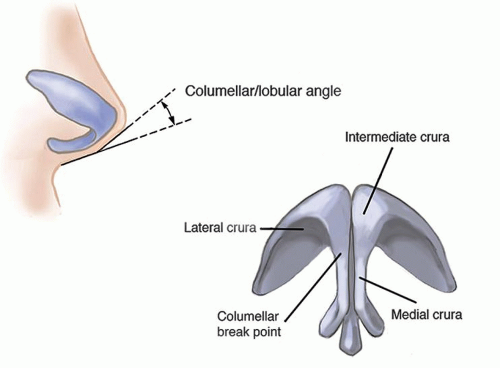 Figure 182.11 The double break is formed by the natural divergence of the intermediate crura. The columellar lobular angle is formed by the intermediate crura diverging into the lateral crura. |
Stay updated, free articles. Join our Telegram channel

Full access? Get Clinical Tree



